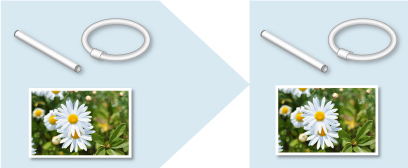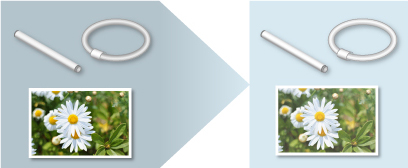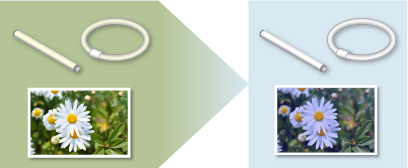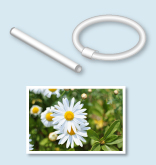Ambient Light Adjustment
When looking at monitors and printed materials, ambient light significantly affects their color appearances.
For this reason, selection of the fluorescent lamp (ambient light) to light the room is very important when performing color management.
| Lighting Condition during Correction | Color Tone when Viewed under Appropriate Lighting | |
|---|---|---|
| Appropriate Lighting Condition |  |
|
| Corrected under appropriate lighting condition | Appropriate color tone | |
| Condition with Inappropriate Lighting Brightness |  |
|
| Corrected under dark condition | Color intensity is low | |
| Condition with Inappropriate Lighting Color |  |
|
| Corrected under a warm white lamp | Bluish color tone | |
Points to Remember when Setting the Ambient Light
Consider the following points when selecting fluorescent lamps suitable for viewing photos.
- Color Temperature
- Color Rendering Properties
- Brightness
Color Temperature
Color temperature, stated in kelvin (K), is a unit to indicate whether the color tone belongs to warm colors or cool colors. Values around 5000 to 6000 K indicate white; the lower values indicate warm colors, and the higher values indicate cool colors.

Commercially available fluorescent lamps can be broadly classified into five types depending on their color temperature.
| Warm White | White | Cool White | Neutral White | Daylight | |
|---|---|---|---|---|---|
| Color Temperature | 3000 K | 3500 K | 4200 K | 5000 K | 6500 K |
Generally, neutral white lamps are recommended for the environment to view photos.
Difference in Appearance by Color Temperature
| Neutral White | Daylight | Warm White |
|---|---|---|
 |
 |
 |
| Appropriate color tone | Bluish color tone | Yellowish color tone |
Color Rendering Properties
Color rendering properties, stated in the general color rendering index (CRI Ra), are the unit to indicate the reproducibility of the color tone. The maximum value for Ra is 100; the higher the color rendering properties, the more faithful color tones can be seen.
When performing color management, it is appropriate to use high color rendering type fluorescent lamps (color rendering properties: Ra 90 or higher) or triphosphor fluorescent lamps.
Lighting Brightness
The lighting affects photos whether it is too bright or too dark.
Generally, about 500 lx (lux) is recommended when performing color management.
![]() Ambient Light Recommended by Canon
Ambient Light Recommended by Canon
- D50 fluorescent lamps designed for color evaluation (color temperature: 5000 K, high color rendering properties)
- Brightness when viewing printed materials: 500 lx ± 125 lx
![]() Tip
Tip
Fluorescent Lamps Used at the Professional's Work Site
At the professional's work site, fluorescent lamps designed for color evaluation with high color rendering properties (D50, color temperature: 5000 K, color rendering index: 90 or higher) are mostly used. If they are not available, the neutral type fluorescent lamps can be substituted for them.
Notes on Ambient Light
-
Mixed light
Even if you put much effort on fluorescent lamps, color temperature and color rendering properties will be affected if light from a different light source such as indirect lighting is mixed.
-
The location to place photos
When photos are placed on a colored mat, the color of the mat may show through the photos affecting their color tones.
-
Outside light
The sunlight from windows affects the color tones of photos since it changes with time. Outside light should be blocked by curtains or the like.
-
Colorful posters, stationery, etc.
Reflected light may affect the color tones of photos.
Using a Desk Lamp as a Fill Light
If changing the lighting of the whole room to fluorescent lamps designed for color evaluation is not an option, you can see accurate color tones by using a fluorescent desk lamp.



